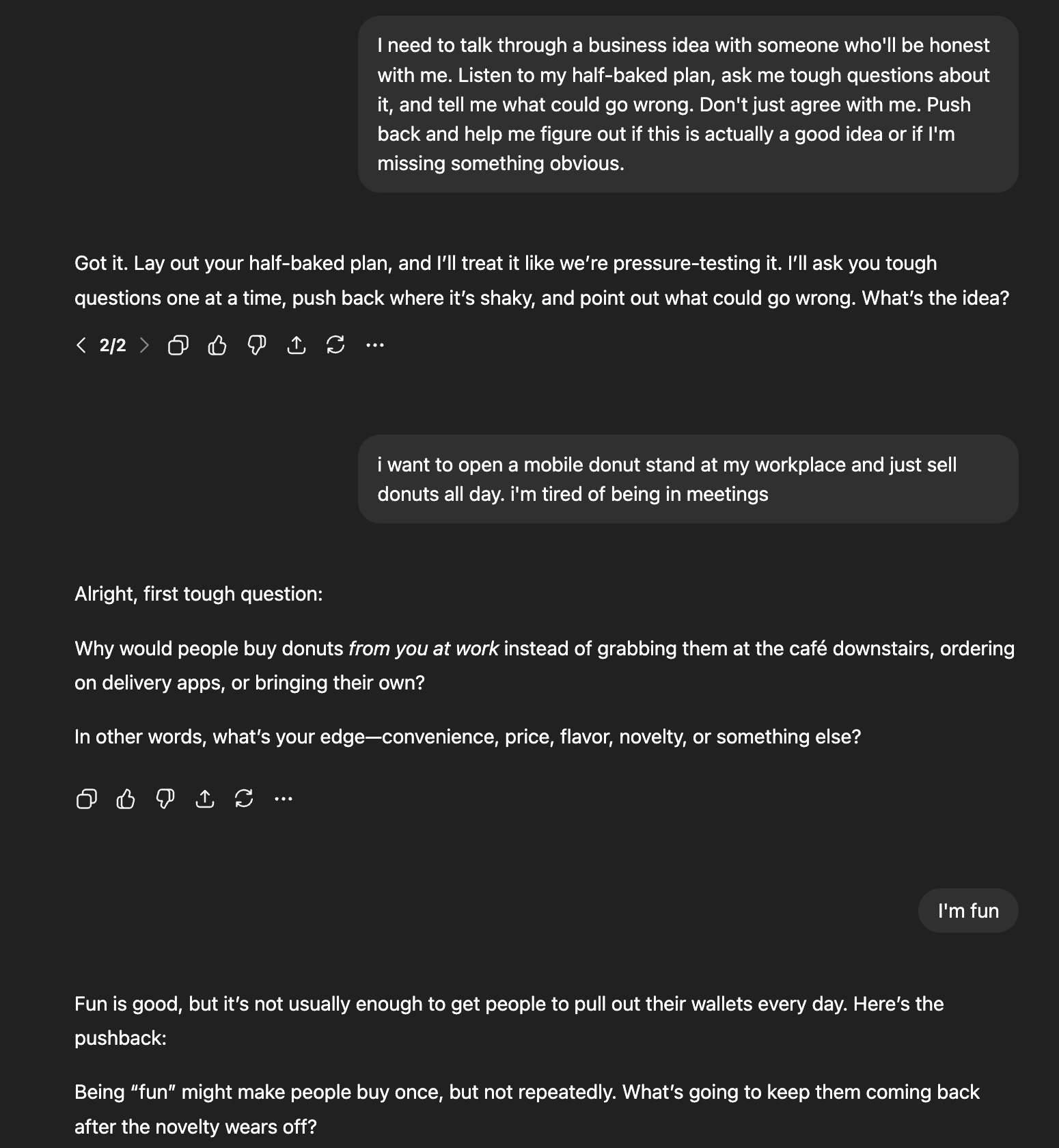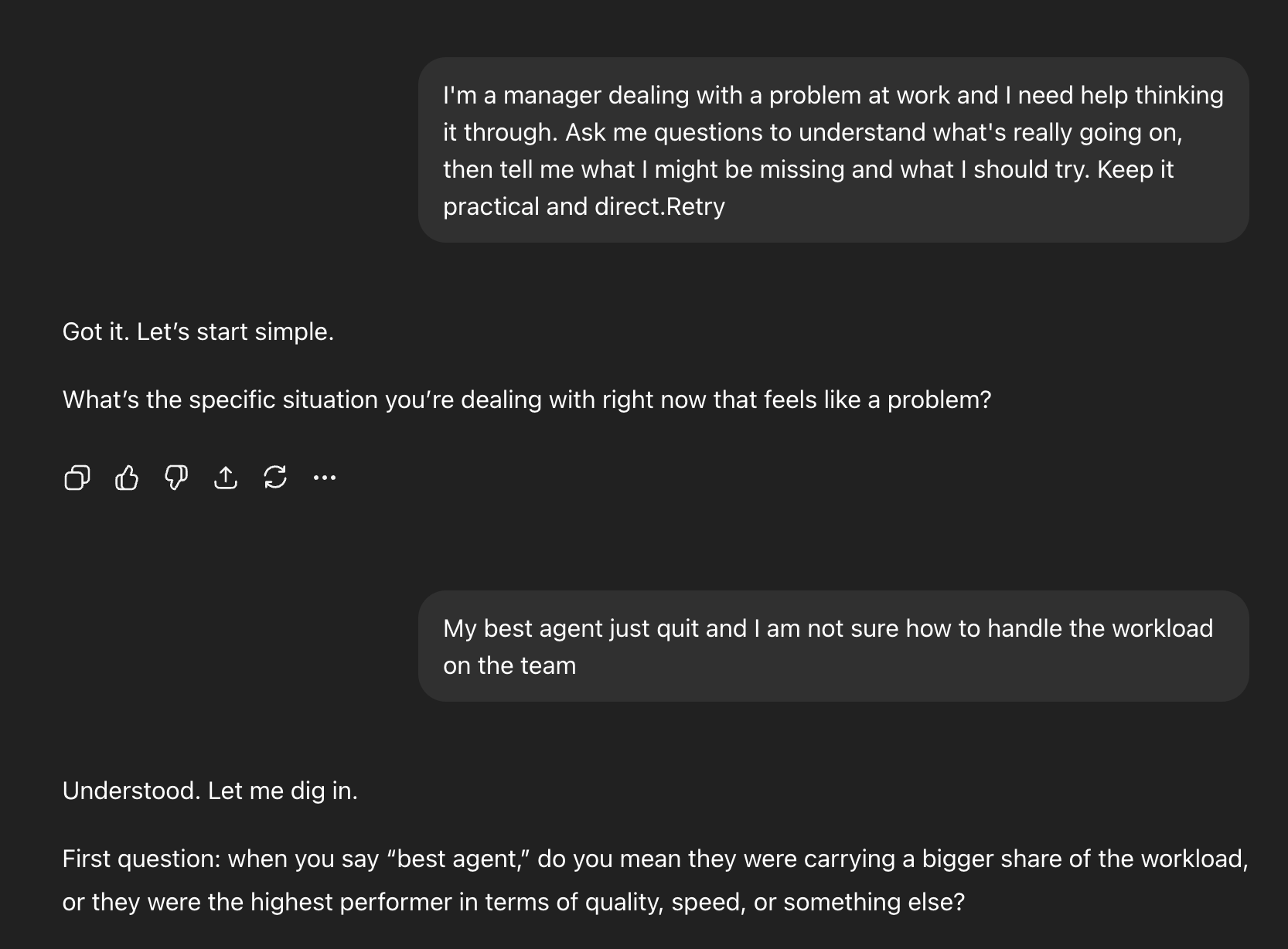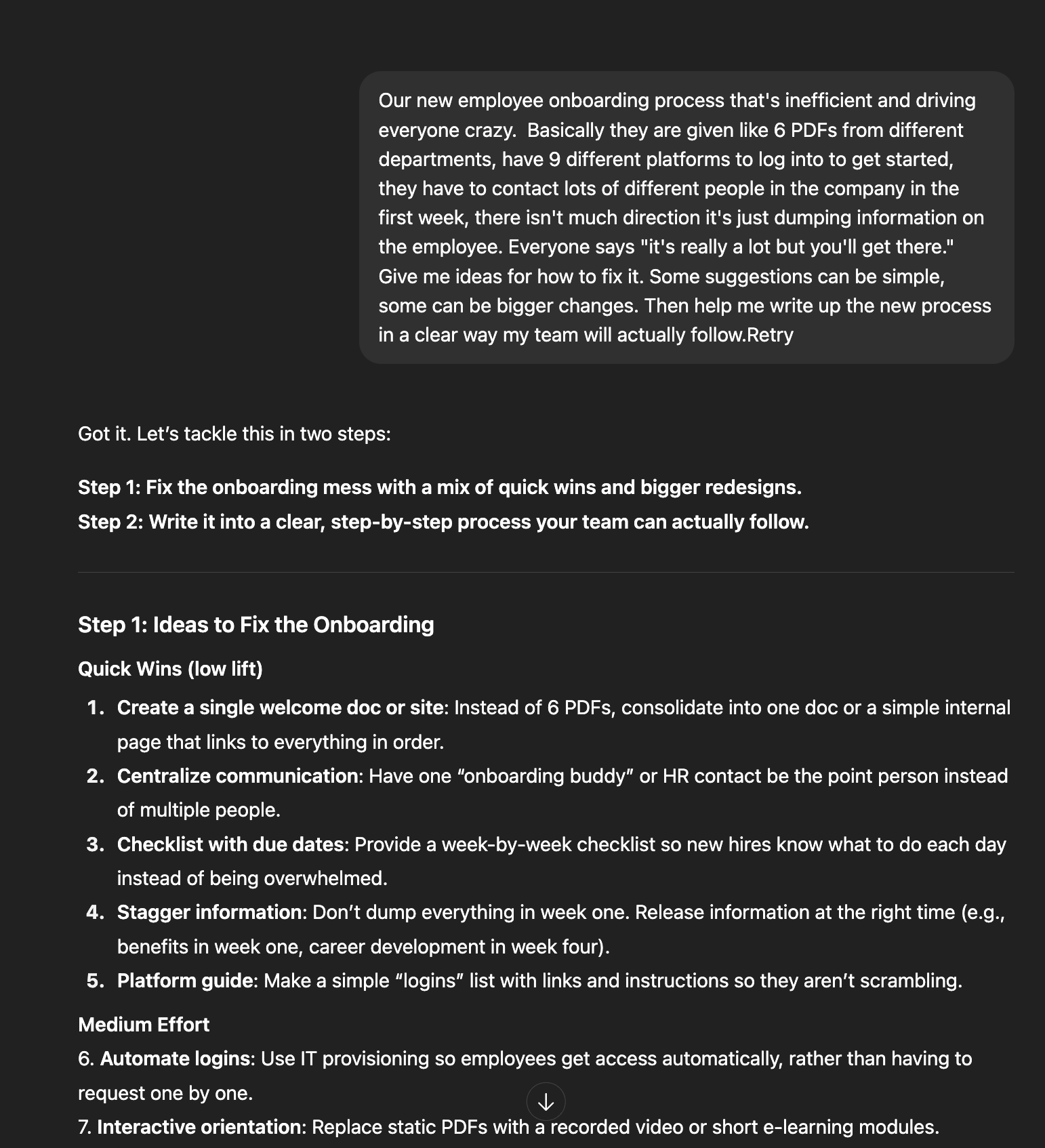Best Uses of ChatGPT for Managers in 2025
Let's be honest: management is exhausting. Between back-to-back meetings, endless emails, performance reviews, and actually trying to do your job, there's barely time to think, let alone be strategic about how you lead.
Enter ChatGPT. It's not going to manage your team for you but it can handle a lot of the cognitive heavy lifting that eats up your day. Here's how managers are using ChatGPT for work in 2025, with practical ChatGPT use cases for managers that actually save time.
Using ChatGPT at work to think through some new ideas
Your 24/7 Thinking Partner
Ever wish you could bounce ideas off someone at 11 PM without annoying your spouse or bothering your boss? ChatGPT is that person. Throw your half-baked ideas at it, ask it to poke holes in your logic, or have it play devil's advocate on that new initiative you're considering.
"Should we reorganize the team?" "What am I missing about this product launch?" "Why does this project feel doomed?" Ask it anything. The quality of what you get back depends on how much context you give it, but having something to think out loud with is genuinely useful. This is one of the best ways managers can use AI at work for strategic planning.
Writing Stuff That Doesn't Sound Like a Robot
The irony of using AI to sound more human isn't lost on anyone, but here we are. Using ChatGPT for business communication is incredibly effective for drafting the communication minefield that is modern management. Using ChatGPT for business communication is one of its strongest applications.
Need to announce a policy change without triggering panic? Draft a tricky performance feedback email? Explain a complex project update to executives who definitely won't read more than three paragraphs? Give ChatGPT the basics and let it help you find the right tone.
The trick is editing it into your actual voice afterward. Your team can tell when you've copy-pasted something generic, so treat it like a first draft from an intern: helpful structure, needs your personality.
Making Meetings Slightly Less Worse
ChatGPT won't make your meetings shorter (we wish), but using ChatGPT for meeting productivity can make them way more effective. Before a meeting, have it help you create an actually focused agenda. After meetings, paste in your messy notes and ask it to extract action items and owners. These ChatGPT productivity tips for managers can save hours each week.
For one-on-ones, it's great at suggesting conversation starters beyond "so, how's it going?" Give it context about what your direct report is working on, and it'll suggest meaningful questions that show you're actually paying attention.
Performance Reviews Without the Dread
ChatGPT can't write reviews for you (please don't), but using ChatGPT for employee feedback can help you articulate things more clearly.
Feed it bullet points about someone's work, and ask it to help you phrase things constructively. It's particularly good at helping you balance "you need to improve" with "here's what you're doing well" without sounding like you're following a script.
Just remember: generic AI feedback is worse than no feedback. Use it to organize your thoughts, then rewrite everything in your own words with specific examples. This is how managers should use ChatGPT at work for employee reviews. ChatGPT for performance management should be a starting point, not the final product.
Using ChatGPT to get unstuck at work
When You're Stuck on a Problem
Every manager hits walls. A project's going sideways, team dynamics are weird, a process is breaking, and you're too close to see the solution. Using ChatGPT for problem solving is surprisingly useful as a rubber duck that talks back.
Explain your problem in detail (the more context, the better) and ask it what you're missing. Even if its suggestions aren't perfect, the act of articulating the problem often helps you see it differently. And occasionally, it actually suggests something you hadn't considered. Many managers use ChatGPT for problem-solving exactly this way.
Training and Onboarding That Doesn't Take Forever
Building training materials from scratch is time-consuming. Using ChatGPT for employee training can help you draft onboarding docs, create training outlines, or structure a workshop. You'll still need to customize everything for your team's reality, but it beats staring at a blank document.
It's also decent at creating scenarios for practicing difficult conversations. "Generate five examples of how to give feedback when someone consistently misses deadlines" gives you a starting point for management training that feels real. Using ChatGPT for employee training saves preparation time while keeping quality high.
Turning Data Into Stories
You've got metrics. Your boss wants insights. ChatGPT can help bridge that gap. Describe your data and what you're trying to communicate, and it'll help you frame it into a narrative that actually makes sense.
"Our cycle time increased 15% but our quality scores improved 8%" becomes a story about intentional tradeoffs rather than just numbers on a slide. It won't do the analysis for you, but it makes the communication part way easier. This is a solid ChatGPT use case for reporting and data presentation.
Offloading process improvements to ChatGPT
Taking Care of Boring Process Improvements
Most processes in most companies are inefficient because everyone's too busy to fix them. ChatGPT is weirdly good at helping you redesign workflows.
Explain how something works now and where it breaks, and ask for suggestions. You'll get ideas ranging from obvious-why-didn't-I-think-of-that to completely impractical, but it gets you unstuck. Even better, it can help you document the new process in a way people might actually follow. Managers using AI for process improvement often see quick wins here.
Crisis Prep When Things Are Calm
Nobody wants to write crisis communication templates until they need them, at which point it's too late. Use ChatGPT to draft response frameworks for common scenarios during the calm times.
"Customer data breach announcement," "key employee sudden departure," "product recall messaging" (whatever keeps you up at night). Having templates ready doesn't mean you'll use them verbatim, but you won't be starting from zero when everything's on fire.
Learning Management Stuff Without Going Back to School
Management trends change constantly. ChatGPT can explain frameworks like OKRs, give you the gist of that leadership book everyone's talking about, or break down concepts like psychological safety without making you read a 300-page textbook.
Ask it to explain things like you're smart but busy (because you are), and you'll actually absorb it. Using ChatGPT for professional development as a manager is an underrated application.
ChatGPT Is Helpful But Don’t Use It On Autopilot
Be careful with data: Never put actual employee performance details, salary info, or confidential company data into ChatGPT. Use fake names and generic descriptions if you need to work through something sensitive. This is critical when using AI tools in the workplace.
Your voice matters: If every email you send sounds like it came from a corporate communications template, your team will tune you out. Edit everything heavily. Be yourself.
It gets things wrong: ChatGPT is confident about things it shouldn't be. Verify anything important, especially if you're making decisions based on its input.
Give it context: "Help me with team communication" gets you garbage. "I manage a 7-person engineering team that's been missing deadlines because of unclear requirements, and I need to address this without making them defensive" gets you something useful. Effective ChatGPT prompts for managers require specificity.
Keep iterating: The first response is rarely the best response. Push back, ask for alternatives, tell it what's wrong with its suggestions. It's a conversation, not a magic wand.
ChatGPT Is a Manager’s Little Helper
ChatGPT won't make you a great manager. That still requires actually caring about your people, making hard decisions, having difficult conversations, and showing up consistently even when it's uncomfortable.
But it can clear away some of the mental clutter and administrative drag so you have more energy for the parts of management that actually matter. And honestly, in 2025, we'll take all the help we can get.
The managers who figure out how to use ChatGPT at work without letting it replace their judgment are going to have a significant advantage. Not because the AI is doing the work, but because they're getting back time and headspace to do their real job: leading humans. Whether you're exploring ChatGPT applications for team leaders or looking for AI productivity hacks for managers, the key is finding the right balance between AI assistance and authentic leadership.
Want to more support using AI at work? Join our AI Adoption Accelerator for Managers.


